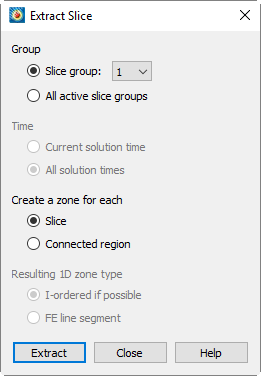14 - 2 Extracting Slices to Zones
Normally, slices are derived from the dataset "on the fly" and do not add any data to the dataset. To extract slices to Tecplot zones, allowing you to retain them even if the slice details are changed, use Data>Extract>Slices.
In most cases it is not necessary to extract slices to zones, as it is possible to apply most style options directly to a slice. When you need to display multiple sets of slices in various directions, or simply want to "freeze" a slice for some other reason, you may wish to extract at least some of the slices to zones.

Extracting slices has the following options:
• Group: Select between an individual group extraction or all active groups extraction, where active means slices visible on the screen.
• Slice Group: Select from the dropdown menu which group is extracted to a zone.
• All Active Slice Groups: Extracts slice groups that are set to active.
• Time: Specify between extracting a slice for all solution times or the current solution time.
• Current Solution Time: Extract a slice for the active solution time.
• All Solution Times: Extract a slice for each solution time.
• Create a zone for each: Specify how each slice is extracted into single or multiple zones.
• Slice: Extracts each slice to a single zone.
• Connected Region: Extracts each slice to its connected regions. Connected regions are defined by zone boundaries and areas of disconnected meshes.
• Resulting 1D Zone Type: Only active when the slice source is not a volume.
• I-ordered If Possible: Creates an I-ordered zone for each slice zone that is a single connected region.
• FE Line Segment: Creates all extracted linear zones as FE-LineSeg zones.
Values in the extracted slice are nodal unless Contour Type is set to Primary Value flood on the Contour page of the Slice Details dialog. In this case, the value location for the extracted slice is the same as for the source zones.